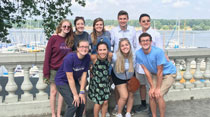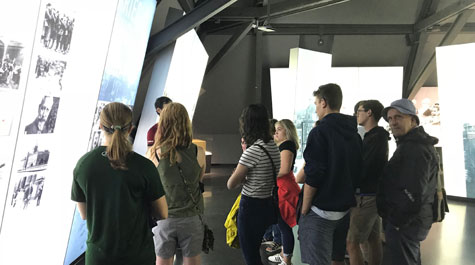Students moved by modern memorials of Holocaust sites
William & Mary students toured Holocaust sites this summer to look at the Third Reich, national socialism and the Jewish people in Germany and Prague through a modern lens.
Select students and faculty members traveled through Germany and the Czech Republic from May 29 through June 9 as part of the COLL 300 credit-eligible program. They explored first hand major Holocaust-related sites to learn about the impact of national socialism on the region.
During the visit, students learned the history and background of the Nazi party, as well as how various groups of citizens were affected both then and now. Sites toured included Munich, Prague, Terezin, the Dachau Concentration Memorial Site, the Documentation Centre at the Nazi Party Rally Grounds and Nuremberg Trials museums in Nuremberg, the Military History Museum in Dresden and the Wannsee Conference Center in Berlin.
“One of our tour guides in Berlin discussed his own family history, which was largely connected to Nazism and destruction,” said Sophie Caplan ’19. “He talked about how his generation in German society is trying to eliminate their feelings of guilt and instead emphasize their responsibility to share their history with others to inform, educate and hopefully impede a similar event from occurring in the future. I found this to be quite an interesting and positive perspective.”
 Careful thinkers and experienced guides sharing their stories at each site gave the visit meaning for Anna Rader ’20.
Careful thinkers and experienced guides sharing their stories at each site gave the visit meaning for Anna Rader ’20.
“The tour guides and docents frequently crafted the personal experience that helped me better understand the native legacy,” Rader said. “At our first site, the National Socialism Documentation Center, the director’s passion for museum curating sparked my interest in Germany’s social memory of the Holocaust that looks drastically different from the social perceptions of World War II.
“Through this local lens and intriguing question, I continued to gain new perspectives and even more questions with each new experience and guide.”
Marc Lee Raphael, Nathan Gumenick Professor of Judaic Studies and professor of religious studies at W&M and leader of the visit, pointed out some highlights.
A visit to the courtroom where the Nuremberg war crimes trials took place, which has been left exactly as it was more than 70 years ago, gave details on all of the approximately 22 defendants tried there.
“The tour is about each of them — what horrible things each of them did and what charges there were against them, how they were defended and prosecuted, and what happened to them,” Raphael said. “It’s an education in the entire Nazi party operation.”
Students saw creations of all kinds left behind by residents of Terezin, Czech Republic, all of whom were later transported to Auschwitz and murdered there. In the Nazi-established Jewish housing and concentration camp at Terezin, the Nazis let the residents pursue their hobbies on evenings and weekends, and the creative works of thousands of people are still displayed there.
The visit’s centerpiece was a late afternoon stop at Lidice, a small town outside of Prague, Czech Republic. There, two Czechoslavakians assassinated the Nazi leader in Prague in 1942, and Nazis found and killed the assassins in a church in Prague where they were hiding.
The Nazis retaliated by destroying the entire town of Lidice, shooting the men, deporting the women to a slave labor camp and sending children to a death camp. The site has been preserved exactly as it was in 1942, and all that’s left today are foundation stones and a commemorative sculpture by a Czech artist erected as a memorial to the children.
“She had a school photograph of every elementary school child and made a life-size model of each of the children, side by side, about 75 of these children,” Raphael said. “It’s impossible for anybody to look at this and not cry. In addition, she has them all facing different directions.
“There’s nothing you can do or see that has the impact. If students forget everything else 10 years from now that they saw, they are unlikely to every forget this memorial.”
Seeing all of the Stolpersteine in the cities toured stuck especially with Grace Bruce ’21. The small brass stones are placed in front of the former homes of Holocaust victims, stating their name, year of birth and place of death.
“The stones truly illustrate how millions of ordinary citizens had their lives completely uprooted during the Holocaust,” Bruce said. “They showed Holocaust victims were not only defined by their imprisonment and murder. They had names; they had homes. These small memorials are just one of many ways in which this trip conveyed to us the more personal side of an incomprehensible tragedy.”
Aaron Groves ’20 was struck by the idea of memorial culture present in many of the cities and sites visited.
“Germany has been incredibly intentional about owning its past and taking responsibility for the future,” Groves said. “They did not erect Holocaust memorials in order to shame or embarrass themselves. The sites have been established in order to remind ordinary citizens of the horrendous acts that mankind is capable of.”
Dachau and Lidice will stay with him the longest.
“Walking on the grounds of a concentration camp makes it difficult for me to fathom that such atrocities occurred less than a century ago,” Groves said. “My experience at Dachau has helped me to recognize the importance of intentional aid to those on the outskirts of society and to grasp the fragility of political freedom.”
 Skip to main content
Skip to main content

